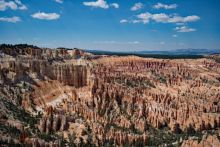Geoscience Currents transmit snapshots of the many facets of the geoscience profession, in-depth case studies of how geoscience is applied, factsheets that provide rigorous introductions to a range of geoscience topics, workforce trends, and career paths.
Partner with us to help support well-informed public policy and decision making with expert, impartial geoscience information. Visit our Sponsorships page for more information or email sponsorships@americangeosciences.org.
Displaying 201 - 210 of a total of 225 items

July 22, 2009
The most significant choke point in the geoscience career pipeline is at its source: secondary schools. Unfortunately, most U.S. high schools do not provide courses that expose students to the geosciences. This problem is exacerbated by the lack of Advanced Placement courses in the geosciences. A...

July 06, 2009
Salaries for all geoscience-related professions continue to exceed the national mean salary for all other science occupations in 2008. Petroleum engineering salaries averaged $119,400, and salaries for geoscientists (except hydrologists and geographers) averaged $89,300. Salaries for environmental...

June 22, 2009
The 2008-2009 academic year saw a sharp 8% increase in the number of geosciences undergraduates enrolled in U.S. institutions, to a total population of 22,191. This trend was not evident in graduate enrollments, which remained basically flat at 7,846 students. These trends reflect statements from...

June 19, 2009
Geoscience bachelor’s degree recipients tend to have higher student debt load when compared to other science, technology, engineering and mathematics (STEM) degree fields. Most STEM bachelor degree recipients with student loans owe in excess of $20,000. Geoscience master’s degree recipients also...

June 08, 2009
Science, technology, engineering, and mathematics (STEM) have relatively low percentages of bachelor degree recipients with physical disabilities. The average percentage of bachelor degree recipients with physical disabilities in all geosciences degree fields (6.45%) is on par with other STEM...

May 11, 2009
Science and engineering employment comprises 1 to 3 percent of total state employment. States with the highest science and engineering employment as a percentage of total state employment are the District of Columbia (5%), and Arkansas, California, Colorado, Massachusetts, Maryland, Michigan, New...

March 30, 2009
From the end of 2008 through the early part of 2009, an increasing number of representatives from academic institutions began expressing concerns about the viability of their geoscience programs in the face of cutbacks due to the economic downturn. To etter assess this situation, the American...

January 15, 2009
Since 1996, the majority of new geoscience Ph.D. graduates have entered into academic positions (both post-doctoral (PD) and non-postdoctoral (non PD)). Of note, is the increase in new geoscience Ph.D. recipients taking academic post-doctoral positions since 2000. This is due to a variety of...

November 25, 2008
A common assertion is that the number of geoscience degrees granted is dependent on the price of oil. However, this metric requires a response lag greater than oil price change velocity. A more responsive mechanism would likely be the rate of degree completion – that students would be incentivized...

October 09, 2008
The majority of geoscientists in the workforce are within 15 years of retirement age. Data from federal sources, professional societies, and industry indicate the imbalance of the age of geoscientists in the profession. The percentage of geoscientists between 31 and 35 years of age is less than...
Pages
Upcoming Webinars

